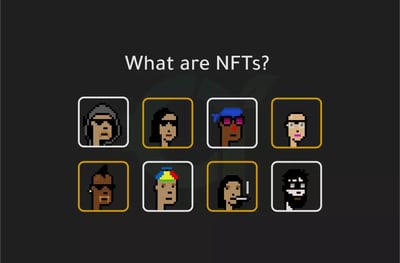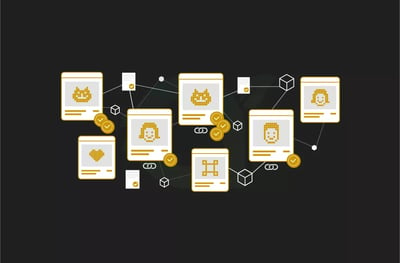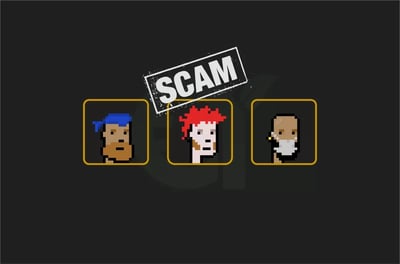Table Of Contents
- Definition of an NFT
- What are NFTs Used For?
- How to Create, Buy and Sell NFTs
- Step 1 – Obtain a crypto wallet
- Step 2 – Buy crypto
- Step 3 – Find a marketplace
- Step 4 – Mint an NFT
- Step 5 – Buy or sell NFTs
- Why Own NFTs?
- 1) It empowers artists
- 2) Collectability
- 3) Investment
- 4) Community
- NFT Usage and Ownership Rights
- NFT Scams
- Rug pulls
- Wash trading
- Phishing scams
- Taxes and NFTs
- The Bottom Line
- The Future of NFTs
Learn About NFTs: A Manual on Everything Non-Fungible Tokens
In March 2021, digital artist Beeple’s group of NFTs sold for more than $69.3 million. This led to NFTs sparking worldwide interest. It was promised they would change the paradigm across nearly every sector of society. There was a solid reason to believe that the revolution would continue with time and technological advancement.
However, there were naysayers. Some experts believed NFTs were just a bubble ready to pop, similar to the dot-com craze of the last decade of the preceding century. Others believed NFTs were here to stay and would change investing forever.
What has happened since? Well, at the time of writing in early 2025, NFTs had experienced a significant rise and subsequent decline in both market value and public interest. Initially celebrated for their potential to revolutionize digital ownership and empower creators, the market has since fizzled out. A 2023 report indicated that 95% of NFT collections had become worthless, underscoring the speculative nature of the market and the risks associated with investing in digital collectibles.
Despite these setbacks, some experts believe that the underlying blockchain technology of NFTs holds promise beyond the initial hype. Potential applications include verifying the authenticity of physical products, enhancing digital rights management, and creating new business models that prioritize smart contracts.
So, there could be lasting value, as some suggest that the technology may still offer useful applications in various sectors, provided that challenges such as market volatility, regulatory concerns, and environmental impact are addressed.
This presentation gives you a crash course in everything about NFTs. We will discuss just what NFTs are, how they are made, and their various drawbacks and benefits.
NFTs are digital assets with no intrinsic value, and their worth depends entirely on what buyers are willing to pay.
Investors are drawn to NFTs for reasons ranging from artistic appreciation to resale profit potential.
Buying an NFT involves researching upcoming projects, securing cryptocurrency like ETH, and choosing a reliable marketplace and wallet.
Platforms like OpenSea, Larva Labs, Rarible, and Rarity.tools are popular destinations for NFT trading.
NFT ownership is proven through blockchain records, which help preserve uniqueness despite the digital item being easily copied.
Investors must account for numerous fees, such as gas fees, transaction costs, and crypto conversion charges.
NFTs are highly speculative and do not produce income, making them riskier than traditional assets like ETFs or real estate.
Although NFTs may offer quick profits for some, most investors will see modest returns and should treat them as high-risk ventures.

Definition of an NFT
NFT is the acronym for “non-fungible token,” which is defined as a “digital asset that links ownership to unique physical or digital items, such as works of art, real estate, music or videos.”
NFTs, therefore, are digital keys that signify ownership. These keys exist on a blockchain in the form of a long string of unique numbers. A blockchain is a distributed public ledger that chronicles transactions. Blockchains gained fame as the underlying process that allows cryptocurrencies to function. Generally, NFTs are held on the Ethereum blockchain, although other cryptos, such as Tezos and Flow, also support them.
Multiple online sources note that NFTs developed from the EFC-721 standard. This is a free, open standard that describes how to build NFTs on Ethereum. It defines the minimum interface (i.e., ownership details, security and metadata) required for the exchange and distribution of farming tokens. The EFC-721 standard was developed by some of the people responsible for the ERC-20 smart contract. Perhaps to make things more confusing, the ERC-1155 standard elevates the concept a step further by reducing storage and transaction costs required for NFTs and then batching multiple types of NFTs into a single contract.
An NFT is minted (created) from digital objects that represent both intangible and tangible items, which even includes Tweets. Original twitter co-founder Jack Dorsey, for example, sold his first-ever tweet as an NFT for more than $2.9 million. NFTs, therefore, are digital collector’s items.
Just as Bitcoin has been proclaimed as the cryptocurrency answer to fiat currencies, NFTs are likewise touted as the digital answer to collectibles. Rather than purchasing an actual oil painting to hang on the wall, the buyer instead gets a digital file to signify they own the oil painting.
They get exclusive ownership rights. Thus, NFTs can have only one owner at a time. Using blockchain technology makes it easy to verify ownership and transfer tokens between owners. An NFT’s creator is also able to store specific information in an NFT’s metadata – artists are able to sign their artwork by including their signature in the file. The technology makes it difficult to alter or counterfeit NFTs.
To add to the understanding of NFTs, perhaps it is wise to become familiar with the economic concept of “fungibility.” Fungible items may be exchanged with one another easily because their value is not tied to their uniqueness. Thus, if you exchange one $20 bill for another $20 bill, the value of what you have is the same even though the item now in your hand has a different serial number than the previous $20 bill. If something is non-fungible, it has unique properties so it cannot be interchanged with something else. This could be a house or a painting (think Mona Lisa), each of which are one of a kind. Yes, it is possible to photograph the painting or purchase a print, but there still is only one original painting. With NFTs, each token has its own unique properties and is not worth the same amount as seemingly similar or secondary tokens.
Example: a fungible transaction is when you purchase a cup of coffee with a repeatable flavor and volume; you pay the barista and you get your drink, which could be indistinguishable in taste from the next drink the barista prepares. However, NFT transactions are similar to trades in professional sports, i.e., when the Toronto Raptors, in 2018, traded DeMar DeRozan for Kawhi Leonard, which led to Toronto’s first-ever NBA title. The trade was a one-of-a-kind transaction, there, it was non-fungible.
Also, NFTs are non-divisible. The token is the basic unit of the NFT and cannot be divided into smaller denominations. There are indications, however, that NFTs may be divisible in the future. To be clear, NFTs cannot be divided, but their ownership can be divided. So, theoretically, 10 people could co-own the single NFT of a rare painting.
Further, NFTs are immutable. This means they cannot be altered once they have been encoded through blockchain technology. The legitimacy and originality of the item is validated through the blockchain in which it is stored. Consider, however, that, unless otherwise stated, when you purchase an NFT, you are not buying any of its intellectual property rights or commercial rights to any underlying assets.
As you can see, the legal details can become rather complicated, and we will, therefore, dive into this more in further sections here.
Possibly, NFTs’ most obvious benefit is market efficiency. Converting a physical asset into a digital asset simplifies processes and removes intermediaries. With NFTs representing digital or physical artwork on a blockchain, there is no need for agents, and artists are able to connect directly with their audiences. NFTs also are excellent for identity management.
As well, NFTs are able to democratize investing by fractionalizing physical assets, such as real estate; it is much easier to divide a real estate asset among multiple owners than it is a physical asset. The tokenization asset need not be restricted to real estate, but it may extend to such other assets as artwork. Therefore, as we have said, a painting need not always have a single owner. A painting’s digital equivalent can have multiple owners, with each responsible for a fraction of the painting. Such an arrangement may well increase a painting’s worth and revenues.
NFTs’ most exciting possibility is in the creation of new markets and forms of investment. Contemplate a piece of real estate that is parceled into multiple divisions, each of which contains different characteristics and property types. One section might be next to a beach, another is in an entertainment complex, and perhaps a third is in a residential district. Depending on its characteristics, each piece of land is unique, priced differently, and represented with an NFT. Real estate trading, which is an otherwise complex and bureaucratic situation in real life, can be simplified by incorporating relevant metadata into each unique NFT.
Ethereum’s blockchain has a virtual reality platform, Decentraland, which has already implemented such a concept. As NFTs become more sophisticated and integrate into the financial infrastructure, it may become possible to employ the same concept of tokenized pieces of land, which differ in location and value, in physical work.
Various types of digital goods can be “tokenized,” such as items in games, stills of video from live broadcasts, or artwork. NBA Top Shots is one of the largest NFT marketplaces. While the NFT that conveys ownership is added to the blockchain, the file size of the digital item does not matter because it remains separate from the blockchain.
Based on the individual NFT, copyright or licensing rights might not come with the purchase, but that is not necessarily the situation. This is similar to buying a limited-edition print that does not necessarily grant exclusive rights to the image.

What are NFTs Used For?
NFTs and blockchain technology present content creators and artists with a unique opportunity to monetize their creation. Thus, artists no longer have to rely on galleries or auction houses to sell their art. Rather, the artists are able to sell it directly to the consumer as an NFT, allowing the artists to retain more of the profits. Further, they are able to program in royalties so they will receive a percentage of sales whenever their art is sold to a new owner – an attractive feature because artists do not receive future remuneration in the traditional art world after their art is first sold. These are some of the questions you may have wanted answered before you understood how to invest in NFTs.
The Beeple sales mentioned at the beginning of this guide set a precedent, as well as a record for the most expensive pieces of digital art sold thus far. The sale was of a collage made up of Beeple’s first 5,000 days of work. Although anyone is able to view the individual images, or even the entire collage, online for free, why then are people willing to spend millions on something for which they easily are able to screenshot or download? Simple, because an NFT allows the buyer to “own” the original item. Further, it contains built-in authentication, which proves ownership. There are those who argue that collectors value digital bragging rights nearly as much as the item itself.
Art is not the only possible moneymaker with NFTs. One source we found noted how Nyan Cat, a 2011-era GIF file of a cat with a Pop-Tart body, sold for nearly $600,000 in February. Meanwhile, NBA Top Shot generated more than $500 million in sales as of late March. A single LeBron James highlight NFT brought in more than $200,000. At the same time, celebrities, such as Snoop Dogg and Lindsay Lohan, have now hopped on the NFT bandwagon, having released unique memories, artwork and moments that are not securitized NFTs.
Cryptokitties perhaps is the most famous use case for NFTs. Launched in 2017, cryptokitties are digital presentations of cats with unique identifications on Ethereum’s blockchain. Each feline is unique and has a price in ether. The cats reproduce among themselves and produce new offspring, each with different attributes and valuations compared to their parents.
In only a few weeks following their launch, cryptokitties developed a fanbase that spent $20 million worth of ether to purchase, nurture, and feed them. There are enthusiasts who spent upward of $100,000 on the effort. More recently, the Bored Ape Yacht Club (BAYC) stimulated controversy for its high prices, celebrity following, as well as the high-profile thefts of some of its 10,000 NFTs.
While BAYC and cryptokitties use cases may appear trivial, others have more serious business implications. NFT have been used, for example, in private equity transactions, as well as in real estate deals. One of the implications of enabling multiple types of tokens in such a contract is the ability to provide escrow for different types of NFTs – from real estate to artwork – into a single financial transaction.
Recommended Brokers
How to Create, Buy and Sell NFTs
The process of creating, buying and selling NFTs is rather simple:
Step 1 – Obtain a crypto wallet
A crypto wallet is a physical device or computer program permitting you to transfer and store digital assets. Two types of crypto wallets exist: software (hot) and hardware (cold) wallets. For shorter-term trades and minting, a hot wallet (which is Internet-enabled) is the way to go. For safety concerns, however, you should use a hardware wallet to store your most valuable assets.
Step 2 – Buy crypto
Some NFT marketplaces, such as MakersPlace and Nifty Gateway, allow you to trade NFTs using traditional methods. Others, such as OpenSea and SuperRate, only allow people to use cryptocurrency. With regard to which crypto you should get, Ether (ETH) is the leader for NFT transactions. It is the native currency of the Ethereum blockchain and is able to be purchased in a few different ways, including via such major trading platforms as Gemini and Coinbase. These permit users to purchase ETH with a credit card or bank account.
Taking into account the high transaction costs and environmental impact associated with ETH, however, some people want to use cryptos from other blockchains to trade NFTs. Such alternatives as Binance (BSC), Flow (FLOW), Tezos (XTZ), and Solana (SOL) also support NFT transactions. For the beginner, however, it may be best to stay with ETH and the Ethereum blockchain because it has many more marketplaces and users.
Step 3 – Find a marketplace
Something to consider when choosing a marketplace is whether you intend to mint one NFT at a time and place it up for auction or mint a collection or batch of NFTs that are each individually priced. If your choice is the latter, consider some of the world’s largest NFT marketplaces. OpenSea is the most popular and has more than a million active user wallets on its platform. Rarible and LooksRare are two of OpenSea’s strongest competitors. If, however, you intend to mint one-on-one NFTs, platforms such as Zore, Foundation, and SuperRare are your best bet.
Even though these platforms, and others, are host to thousands of NFT creators and collectors, be certain to carefully research them before buying. Some artists have become victims to impersonators who have listed and sold artists’ work without their permission.
Further, the verification processes for creators and NFT listings are not consistent across platforms, with some being more stringent than others. Rarible and OpenSea, for example, do not require owner verification for NFT listings. Buyer protections appear to be, at best, sparse. Thus, when shopping for NFTs, it may be best to keep the old adage “caveat emptor” (buyer beware) in mind.
Do consider, however, that the value of an NFT is solely based on what someone is willing to pay for it. Thus, demand will drive the price rather than technical, fundamental, or economic indicators, which typically influence stock prices and, at least generally, form the basis for investor demand. This all means that an NFT could easily resell for less than you paid for it. Or, you may not be able to sell it at all if no one wants it.
Be prepared, though, and minting comes with an initial cost. Most of the time, you only need to pay a “gas” fee (transaction fee) to mint, but sometimes marketplaces add on further costs. Make certain you do your due diligence when researching royalty splits. You are not, for example, guaranteed to have cross-platform royalties when you mint on a platform such as Rarible or OpenSea. Note that there are smart contract and minting tools, such as CXIP, that help you with this problem, and OsSplits, which helps with automated royalty splits to ensure you receive secondary sales royalties no matter where your NFTs are resold.
Step 4 – Mint an NFT
New NFTs are created via a process called “minting,” which is the procedure of associating a specific set of data – the NFT – with a specific asset or object. When choosing a unique asset, keep in mind that you must own the copyright and intellectual property rights for the item you want to mint. If you create NFTs using assets you do not own, you could easily end up in legal trouble.
After selecting a marketplace and creating an account, you can begin the minting process. The process is slightly different for each marketplace, but you typically will need to upload the file you plan to associate with your NFT and fund the transaction using ETH or another cryptocurrency, depending on which blockchain you are using. It is also possible to mint a physical, real-world object, although the process is more complex than what we cover here.
After the minting process is completed, you will have all the relevant information regarding your new NFT, which will be registered to your digital wallet. You can now keep it, sell it, or trade it as you wish.
Step 5 – Buy or sell NFTs
Please note that some NFTs may not be available in the open marketplace or may only be purchased through specific vendors. CryptoPunks, for example, historically have been sold through the LarvaLabs Website rather than through a public marketplace.
Once you have found an NFT you wish to purchase, you may have the opportunity to buy it outright. Of course, you may need to bid on the NFT of your choice and wait until the auction closes. If you are the highest bidder, after the auction closes (or if the seller otherwise accepts your bid), the transaction will complete and ownership of the NFT will transfer to your wallet. You then know the NFT and can sell or display or sell it as you see fit.
Selling your NFT follows a similar process as we have outlined above. You will need to set up the auction in the marketplace of your choice. Take time to understand all of the fees and different types of auction methods available to you before initiating the sale. Once the auction is complete, the NFT will be automatically transferred from your possession and the proceeds from the transaction will be transferred to you.

Why Own NFTs?
Demand for NFT art has exploded recently. There remains, however, a lot of skepticism. Remember, NFTs are generally tied to digital files. How is owning such an NFT different from a screenshot of a photo? Does “proof of ownership” have any meaning? To help you decide, here are some principal reasons why people own NFTs:
1) It empowers artists
Auction houses, publishers and producers often strong-arm creators into contracts that do not serve their interests. With NFTs, however, artists can mint and sell their work independently, allowing them to retain the intellectual property and creative control. Artists also can earn royalties from all secondary sales of their work. Thus, NFTs have the potential to create fairer models by bypassing the gatekeepers who currently control creative industries. Many individuals buy NFTs because it is a way of empowering and financially supporting the creators that they love. It is not dissimilar to supporting the fair-trade movement in food purchases, thus ensuring that farmers and growers in the value chain get their just rewards.
2) Collectability
Despite costing less than five cents to make, a 1952 Mickey Mantle rookie card sold for $5.2 million, essentially because of the history, rarity and cultural relevance of the card. NFTs are, in many ways, the digital version of this. For individuals who desire to build a collection of digital assets, NFTs offer a unique opportunity that has not existed outside of traditional art markets and collectibles ever before.
3) Investment
Some NFT owners just want an asset that will increase in value. Thus, some collectors treat NFTs as an investment, similar to traditional art. Beeple’s Everydays: The First 5000 Days sold at Christie’s for $69.3 million in March 2021 and it is possible it could one day change hands for more money.
While this may appear strange to some, everyone can see and interact with the image. As noted earlier, however, there exists only one NFT owner. This is enough for some. Yet, market volatility makes NFT investment a high risk, complete with the serious potential for major losses.
4) Community
NFT ownership also comes with community. Owning an NFT, for many collectors, is a matter of identity. Many creators have turned their NFT projects into vibrant communities. Perhaps the best example of community building in relation to an NFT project is BAYC. Collectors obtain access to a members-only discord, a vote in the future of the project, exclusive merchandise, tickets to virtual gatherings and more.
NFT Usage and Ownership Rights
NFT Scams
NFTs are still a new phenomenon. The fact that they are high-priced and headline-making machines is attracting fraudsters and scammers. Therefore, be wary. Some may attempt to sell you something as an NFT when it is not. Others may claim to have the right to sell an NFT of a piece of work they do not own and did not create. As a result of this nefarious activity, the market is vulnerable to scams that can take advantage of unsuspecting collectors. Here are a few scams and other problems with the NFT market that should keep you on alert:
Rug pulls
Although large, generative projects are preferred by collectors, there is not always safety in numbers, and no NFT project is entirely without risk. Many projects have fallen apart because of rug-pull scams. A rug pull occurs when the project creators take the investment funds for the project and then disappear. By absconding with all of the money, it leaves collectors with a valueless asset.
While certainly unethical, these types of rug pulls often are not illegal. Yes, they are unethical. If a project promises to donate funds and then chooses to keep the money, there isn’t much anyone can do. Only in rare instances may a rug pull count as fraud, but this often is not the situation.
Rug pulls may also occur when NFT developers remove the ability for investors to sell their tokens. These types of rug pulls are illegal and you may be able to recoup your money. However, it may cost you a lengthy court battle. Further, many NFT creators do not use their legal names; thus, it may be difficult, or even impossible, to track them down.
Wash trading
Along with stocks and other collectibles, market manipulation may take place during NFT auctions. Working in unison, a group of potential buyers can drive up the price of an NFT by artificially inflating the bid price until an unsuspecting buyer joins the fray. Following the sale, the asset deflates in value, leaving the buyer with a valueless NFT. A common way of doing this NFT is with wash trading, which occurs when a user controls both sides of an NFT trade, selling it from one wallet and purchasing it from another.
When many such transactions are executed, the trade volume rises. The result is that it appears the underlying asset is highly sought after, which increases the value (price) of the NFT in question. In fact, some NFT wash traders have executed hundreds of transactions through self-controlled wallets to attempt to increase demand.
Phishing scams
Through NFT giveaways, fake advertisements, or some other form of coercion, scammers sometimes will ask for your private wallet keys and/or other sensitive information, such as your seed phrase. These are just a few types of the ever-increasing number of crypto scams.
Based on the information they obtain, the scammer can access your wallet and remove any cryptocurrency or NFTs stored within or sign transactions without your consent. With blockchain decentralized and often anonymous (i.e., no regulatory authority and individuals do not have to submit proof of identity to use it), there generally is no way to recover your assets if this occurs.
Like password phishing emails, these scams come in all forms and can be challenging to spot if you are not looking for them. Reminder: never share your seed phrase or private keys with anyone because they can access your funds. Remember, you should only follow links from official websites and accounts, which is sometimes not safe.
Taxes and NFTs
Although tax responsibilities vary from country to country, because of the trading value for most NFTs, acquiring a large sum of money in this way likely will be considered capital gains. For the NFT creator – you have minted and sold your own NFTs – your income likely will be considered some form of business income and you will need to claim it when filing your tax returns. While specifics will vary based on your region, NFTs are not a tax-free investment. Be careful if you plan to treat them as such.
Although NFTs are also subject to capital gains taxes – similar to when you sell stocks at a profit – because they are considered collectibles, they may not receive the preferential long-term capital gains rates stock does and may even be taxed at a higher, collectibles tax rate. Note that the US Internal Revenue Service has not yet ruled as to what NFTs are considered for tax purposes. Keeping that in mind, the cryptocurrencies used to purchase the NFT may also be taxed if they, too, have increased in value since you bought them, meaning you may want to check with a tax professional when considering adding NFTs to your portfolio.
The Bottom Line
The Future of NFTs
Currently, NFTs are still in their infancy. With possible technology applications seemingly limitless, who knows where NFTs will go from here. As with all market assets, the principles of supply and demand apply to the NFT marketplace. Buyers should remain cautious, as they need be with any type of investment, and remain aware as the market evolves.
As stated earlier, an NFT is only as valuable as what others are willing to pay for it. NFTs able to build a deep connection with collectors and investors have shown an increased likelihood of showing long-term staying power.
Both collectors and investors are able to understand the current value for NFTs better by viewing previous and similar sales on established marketplaces. NFTs’ long-term viability will rest on the distinction of their utility, not merely the theoretical. As with other collectibles, this will occur once owners view NFTs as uniquely valuable experiences or features. NFT communities will develop and grow, which will help to maintain prices and markets and strengthen the trust in their long-term survival.
Speculation is that NFTs could play some role in the metaverse of the future, principally by acting as a digital representation of the physical objects you possess. This also could take place with your digital avatar. If NFTs are used to represent items in a video game on a unified blockchain, items and skins can be moved among all games using that blockchain.
Skeptics argue that NFTs don’t really have a future. They say NFTs are merely a passing fad and may ultimately be relegated to a niche part of a larger market, similar to the trajectory with collectible card games and other vintage collectibles.
It is difficult to say what vision of the future is accurate. Given how young NFTs are at this moment in time, the only way to know for sure is to wait and see. Where NFTs stand now is likely to look vastly different within a short period of time.
After the 2021 hype, it seems obvious, looking back, that it was only a matter of time before the NFT bubble popped. However, many people hold out hope that they are here to stay. Use cases for NFTs go far beyond just digital art and video games and may translate to legal contracts, proof of ownership, licensing, certifying authenticity, and much, much more.
Recommended Brokers
FAQ
Non-fungible tokens can digitally represent any asset, including both online-only assets like digital artwork and “real” assets, such as real estate. Further examples of assets that NFTs can represent include in-game items such as avatars, digital and non-digital collectibles, domain names and event tickets.
Many NFTs only may be purchased with ether, thus owning some of the cryptocurrency – and storing it in a digital wallet – usually is the initial step. You then can purchase NFTs by way of the NFT marketplaces, including SuperRare, Rarible and OpenSea.
NFTs use blockchain technology just like cryptocurrency and generally are secure. The distributed nature of blockchains makes NFTs difficult – although not impossible – to hack. One security risk for NFTs is that you could lose access to your NFT if the platform hosting the NFT goes out of business.
The smart money says yes, but prepare for a highly cyclical journey. Blockchain has been successful as the technology that democratizes the money market in the case of cryptocurrencies and now, the art market in the case of NFTs. We should not underestimate the desire of individuals to exist in a market that is fairer and more equitable for all, especially communities like artists that have been undermined for centuries.
As is the case with financial investing, this is entirely up to you. They say beauty is in the eye of the beholder, and artworks can be loved by some and hated by others. It is entirely up to you to choose which class of NFTs in which to invest.






